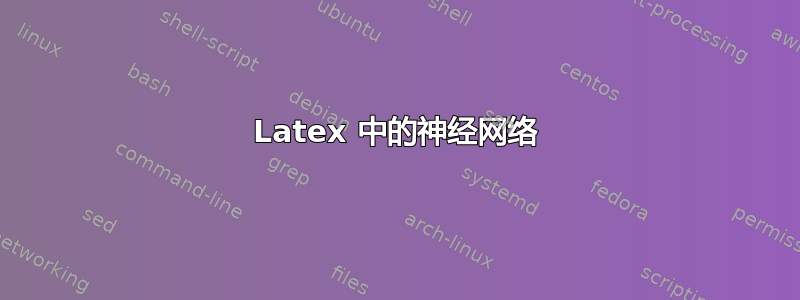
答案1
这是第一个的起点:
\documentclass{article}
\usepackage{tikz}
\usetikzlibrary{positioning,calc}
\tikzset{
redondo/.style={
draw=blue,
line width=1pt,
rounded corners=3pt,
text width=#1
},
punto/.style={
fill=red,
circle,
inner sep=1.25pt
},
tresp/.pic={
\node[punto] at (0.25,0) {};
\node[punto] at (0.5,0) {};
\node[punto] at (0.75,0) {};
},
dosp/.pic={
\node[punto] at (0.25,0) {};
\node[punto] at (0.5,0) {};
},
cuadra/.style={
fill=teal,
minimum size=10pt
},
arr/.style={
line width=1pt,
draw=green!70!black,
->,
>=latex
}
}
\begin{document}
\begin{tikzpicture}[node distance=2cm and 1cm]
\node[redondo=7cm]
(upper)
{};
\pic at (upper.west) {tresp};
\pic at (upper.center) {dosp};
\pic at ([xshift=-1cm]upper.east) {tresp};
\node[]
at ([yshift=-1pt]$ (upper.center)!0.5!(upper.west) $ ) {$\ldots$};
\node[]
at ([yshift=-1pt]$ (upper.center)!0.5!(upper.east) $ ) {$\ldots$};
\node[redondo=5cm,below=of upper]
(middle)
{};
\pic at (middle.west) {tresp};
\pic at ([xshift=-0.75cm]middle.east) {dosp};
\node[] at ([xshift=4pt,yshift=-1pt]middle) {$\ldots$};
\node[redondo=2cm,below=of middle,anchor=east,xshift=-30pt,label={20:$C(w_{t-n+1})$}]
(lowermiddle)
{};
\node[redondo=2cm,below=of middle,anchor=west,xshift=30pt,label={10:$C(w_{t-n+1})$}]
(lowerright)
{};
\node[redondo=2cm,left=of lowermiddle,label={above left:$C(w_{t-n+1})$}]
(lowerleft)
{};
\foreach \Valor/\NodeLabel in {left/n+1,middle/2,right/1/}
{
\pic at (lower\Valor.west) {tresp};
\pic at ([xshift=-0.75cm]lower\Valor.east) {dosp};
\node[cuadra,below=of lower\Valor,label={below:{index for $w_{t-\NodeLabel}$}}] (cuadra\Valor) {};
\node[] at ([xshift=4pt,yshift=-1pt]lower\Valor) {$\ldots$};
}
\draw[arr,dashed]
(lowerleft) to[out=92,in=210] ([xshift=10pt]upper.south west);
\draw[arr,dashed]
(lowermiddle) to[out=150,in=210] ([xshift=-50pt]upper.south);
\draw[arr,dashed]
(lowerright) to[out=30,in=-30] ([xshift=50pt]upper.south);
\foreach \Valor in {left,middle,right}
{
\draw[arr] (cuadra\Valor) -- coordinate (aux\Valor) (lower\Valor);
}
\foreach \Valor/\Angulo in {left/186,middle/193,right/350}
{
\draw[arr] (lower\Valor) -- (middle.\Angulo);
}
\draw[arr] (middle) -- (upper);
\draw[arr]
(upper) --
++(0pt,1cm) node[above] {$i-$th output};
\draw[<->,magenta,dashed,>=latex]
(auxleft) --
++(20pt,-10pt) --
([shift={(-20pt,-10pt)}]auxright) coordinate[pos=0.5] (auxc) --
(auxright);
\draw[->,magenta,dashed,>=latex]
(auxc) -- (auxmiddle);
\node[anchor=south west]
at (auxc) {Matrix $C$};
\node[anchor=north west,align=left]
at (auxc) {shared parameters \\ across words};
\end{tikzpicture}
\end{document}
第二个;用这个你可以轻松创建剩下的一个:
\documentclass{article}
\usepackage{tikz}
\usetikzlibrary{positioning,arrows.meta,calc}
\tikzset{
arro/.style={
->,
>=latex
},
bloque/.style={
draw,
minimum height=1cm,
minimum width=0.5cm
}
}
\begin{document}
\begin{tikzpicture}
\node[]
(input)
{Input};
\node[bloque,below=of input,label={left:$w(t-2)$}]
(inputi)
{};
\node[bloque,below=of inputi,label={left:$w(t-1)$}]
(inputii)
{};
\coordinate[below=of inputii] (aux);
\node[bloque,below=of aux,label={left:$w(t+1)$}]
(inputiii)
{};
\node[bloque,below=of inputiii,label={left:$w(t+2)$}]
(inputiv)
{};
\node[right=of input]
(proje)
{Projection};
\node[bloque,label={above:\textsc{sum}}]
at (proje|-aux)
(projei)
{};
\node[right=of proje]
(out)
{Output};
\node[bloque,label={right:$w(t)$}]
at (out|-aux)
(outi)
{};
\foreach \Valor in {i,ii,iii,iv}
{
\draw[arro] (input\Valor) -- (projei);
}
\draw[arro] (projei) -- (outi);
\end{tikzpicture}
\end{document}







